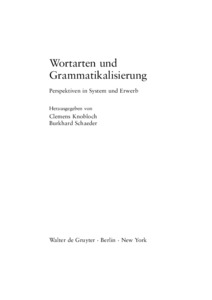| dc.date.accessioned | 2021-04-16T11:31:22Z | |
| dc.date.available | 2021-04-16T11:31:22Z | |
| dc.date.issued | 2005 | |
| dc.identifier | doi:10.17170/kobra-202102093168 | |
| dc.identifier.uri | http://hdl.handle.net/123456789/12718 | |
| dc.language.iso | ger | ger |
| dc.publisher | Walter de Gruyter | |
| dc.rights | Urheberrechtlich geschützt | |
| dc.rights.uri | https://rightsstatements.org/page/InC/1.0/ | |
| dc.subject.ddc | 430 | |
| dc.title | Wort-Arten aus Nähe und Distanz | ger |
| dc.type | Teil eines Buches | |
| dcterms.abstract | The article attempts to deduce pragmatic categories of signs from universal parameters of ‘Nähe- und Distanzsprechen’ (orality and literacy) and thus to establish a systematic account of discourse signs. An essential precondition for this attempt is the analysis of different perspectives on the notion of word. By asking the question whether it is appropriate – from a deductive-pragmatic point of view – to consider the ‘word’ to be the default case of linguistic signs, the author joins the traditional controversy over parts of speech. The article argues that a systematic account of parts of speech on the one hand, and a model of discourse signs on the other, represent independent and complementary perspectives on signs. | eng |
| dcterms.accessRights | open access | |
| dcterms.creator | Ágel, Vilmos | |
| dc.publisher.place | Berlin | |
| dc.publisher.place | New York | |
| dc.relation.doi | doi:10.1515/9783110202090.95 | |
| dc.subject.swd | Semiotik | ger |
| dc.subject.swd | Mündlichkeit | ger |
| dc.subject.swd | Wortart | ger |
| dc.subject.swd | Klassifikation | ger |
| dc.type.version | publishedVersion | |
| dcterms.source.collection | Wortarten und Grammatikalisierung : Perspektiven in System und Erwerb | ger |
| dcterms.source.editor | Knobloch, Clemens | |
| dcterms.source.editor | Schaeder, Burkhard | |
| dcterms.source.identifier | DOI 10.1515/9783110202090 | |
| dcterms.source.identifier | ISBN 978-3-11-018411-2 | |
| dcterms.source.identifier | e-ISBN 978-3-11-020209-0 | |
| dcterms.source.pageinfo | 95-129 | |
| dcterms.source.series | Linguistik - Impulse & Tendenzen ;; 12 | ger |
| kup.iskup | false | |

